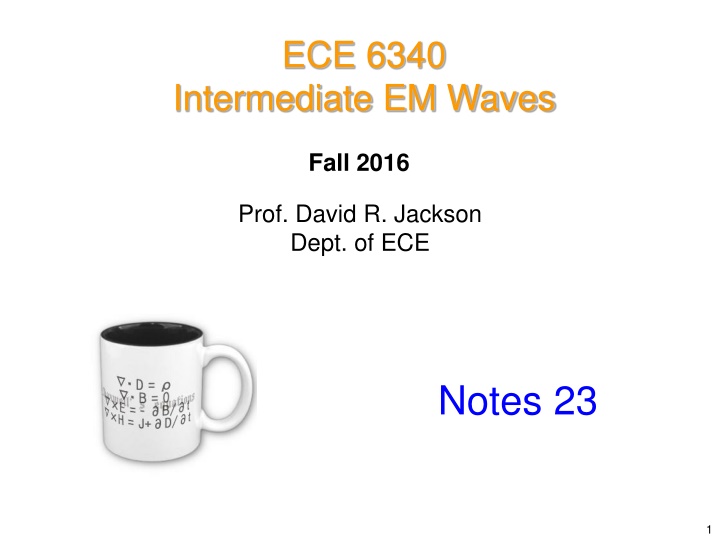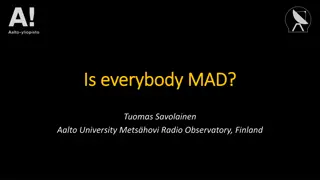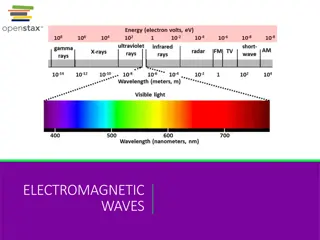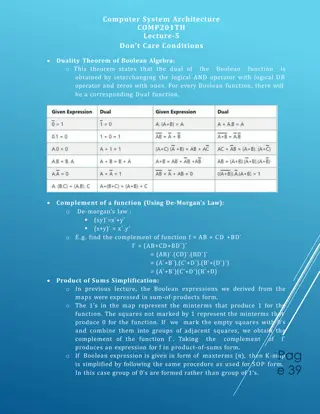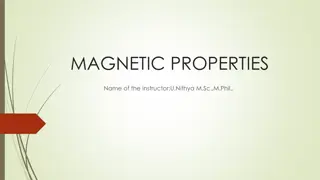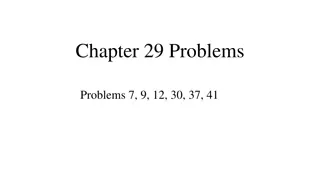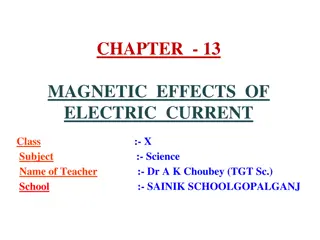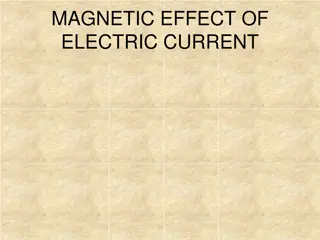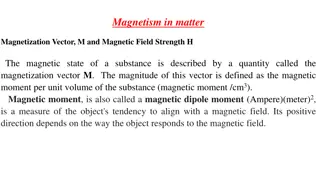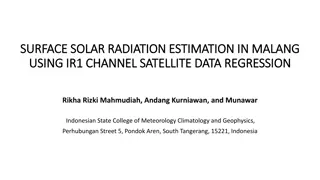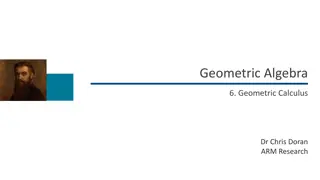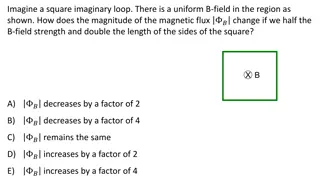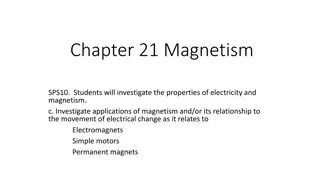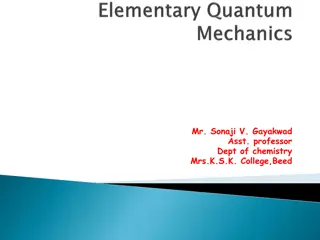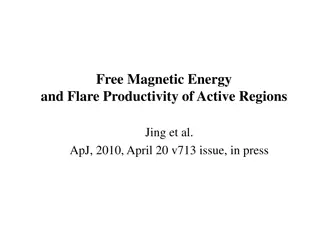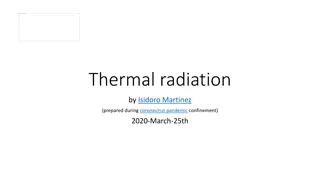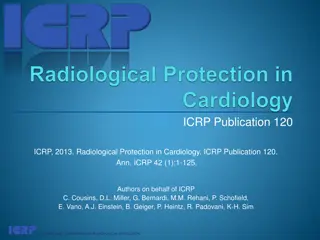Duality in Maxwell's Equations and Radiation from Magnetic Current
In the study of electromagnetic waves, duality in Maxwell's equations plays a crucial role in understanding the symmetry between electric and magnetic fields. This concept allows us to find the radiation emitted from a magnetic current by considering a dual problem with an electric current source. By following specific steps, we can determine the radiation characteristics of the original magnetic current. The content also delves into the shape of the electric current, the dual substitution process, and the general principles involved. Overall, the exploration of duality enriches our understanding of electromagnetic phenomena and their interactions.
Uploaded on Feb 25, 2025 | 0 Views
Download Presentation

Please find below an Image/Link to download the presentation.
The content on the website is provided AS IS for your information and personal use only. It may not be sold, licensed, or shared on other websites without obtaining consent from the author.If you encounter any issues during the download, it is possible that the publisher has removed the file from their server.
You are allowed to download the files provided on this website for personal or commercial use, subject to the condition that they are used lawfully. All files are the property of their respective owners.
The content on the website is provided AS IS for your information and personal use only. It may not be sold, licensed, or shared on other websites without obtaining consent from the author.
E N D
Presentation Transcript
ECE 6340 Intermediate EM Waves Fall 2016 Prof. David R. Jackson Dept. of ECE Notes 23 1
Duality Assume a region of space with sources, and allow for all types of sources and charges: i = E M j H c i = + H J = j E Maxwell s equations now have a completely symmetric form. c = ( ) E v m v ( ) H Note: A magnetic conductivity m is introduced for generality, though it is always zero in practice. = = / j c / j c m 2
Duality (cont.) The substitutions shown below leave Maxwell s equations unaffected. i i J M E H H E i i M J , , m v c c v , , m v c c v 3
Duality (cont.) Example: = + = i i E M j H H J j E c c ( ) ( ) ( ) i i = + = E M j H H J j E c c i = + i = H J j E E M j H c c 4
Duality (cont.) Duality allows us to find the radiation from a magnetic current. Steps: 1) Start with the given magnetic current source of interest. 2) Consider the dual problem that has an electric current source with the same shape or form (Case A). 3) Find the radiation from the electric current source. 4) Apply the dual substitutions to find the radiation from the original magnetic current (Case B). Note: When we apply the duality substitution, the numerical values of the permittivity and permeability switch. However, once we have the formula for radiation from the magnetic current, we can let the values be replaced by their conventional ones. 5
Radiation From Magnetic Current (cont.) Problem of interest: i M ( ) ( ) i = , , x y z , , M f x y z A magnetic current is radiating in free space. Free-space is assumed for simplicity. To be more general, we can replace 0 c 0 c 6
Radiation From Magnetic Current The shape of the electric current is the same as that of the original magnetic current that was given. Case (A): J i only i J ( ) ( ) i = , , x y z , , J f x y z jk r r e 0 i = ( )4 A J r dV 0 r r V 1 = H A 0 7
Radiation From Magnetic Current (cont.) Also = j A E and = j A 0 0 so 1 = j A + ( ) E A j 0 0 8
Radiation From Magnetic Current (cont.) Case (B): M ionly i M ( ) ( ) i = , , x y z , , M f x y z From duality: 1 Case A Case B 1 = E F = H A 0 0 where where jk r r e 0 jk r r e i 0 = ( )4 A J r dV i = ( )4 F M r dV 0 r r 0 r r V V 9
Radiation From Magnetic Current (cont.) Also, 1 = j A + ( ) E A Case A j 0 0 1 = j F + ( ) H F Case B j 0 0 10
Radiation from Magnetic Current Summary jk r r i e M 0 i = ( )4 F M r dV 0 r r V 1 = E F 0 1 = j F + ( ) H F j 0 0 11
General Radiation Formula i i M J i J A Both J i and M i : i M F Use superposition: 1 1 = j A + ( ) E F A j 0 0 0 1 1 = j F + ( ) H A F j 0 0 0 Note: Duality also holds with the vector potentials, If we include these: A F F A 12
Far-Field Case (A) (electric current only): j A r ( , , ) ~ E t ( ) r a ( , ) ~ A 0 4 1 r ~ ( ) H E 0 where jk r e 0 = ( ) r i + ( , ) jk r ( ) = a J r e dV r V 13
Far-Field (cont.) Case (B) (magnetic current only): j F r ( , , ) ~ H t ( ) r f ( , ) ~ 0 F 4 r ~ ( ) E H 0 where i + ( , ) jk r ( ) f M r e dV V 14
Example z Radiation from a magnetic dipole Kmagnetic Amps l y Case B x z I electric Amps Dual problem: l y Case A x 15
Example (cont.) For the electric dipole: ( ) 4 1 r Il jk r = + jk r sin H e 0 0 2 I K Duality: H E So, for the magnetic dipole: ( ) 1 r Kl jk r = + jk r sin E e 0 0 2 4 16
Example A small loop antenna is equivalent to a magnetic dipole antenna, z jk r 2 0 0 k a I e 0 sin E 0 Far-field: 4 r a y I ( ) x = Kl j AI z 0 0 2 A a Kl y ( ) Kl jk r jk r sin E e 0 Far-field: 0 4 x This is the correct far field: The loop can be modeled as a magnetic dipole. 17
Boundary Conditions n 1 Electric surface current: sJ 2 ( n = (1) (2) ) H H J s n 1 Duality: M s 2 ( n = (1) (2) ) E E M s 18
Boundary Conditions (cont.) ( n = (1) (2) ) E E M s n 1 M s 2 19
Example: Magnetic Current on PEC A magnetic surface current flows on top of a PEC. PEC M s n M 1 s 2 PEC ( ) = (1) (2) n E E M s 20
Example (cont.) ( ) n E = = (1) (1) n n n M E M t s s or ( ) 1 t = n E M s Dropping the superscript, we have Note: = n E M The relation between the direction of the electric field and the direction of the magnetic current obeys a left-hand rule . t s n t E 0 M PEC s 21
Example (cont.) n t E 0 M PEC s = n E M t s We then have ( ) = n n n E M t s = n E M Note: The tangential subscript can be dropped. t s Hence This allows us to find the magnetic surface current necessary to produce any desired tangential electric field. = n M E s 22
Modeling of Slot Antenna Problem PEC t E t E 0 t E = t E = 0 0 Side view = n M E s t E 0 n M t E = 0 t E = 0 s 23
